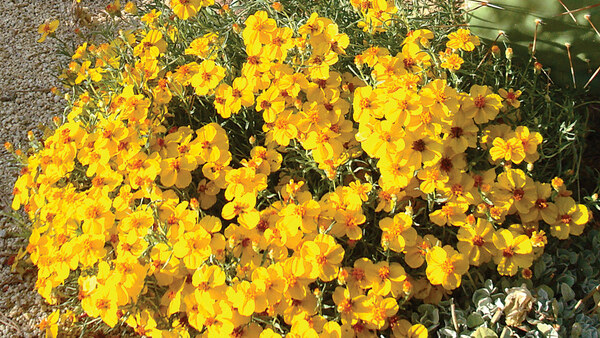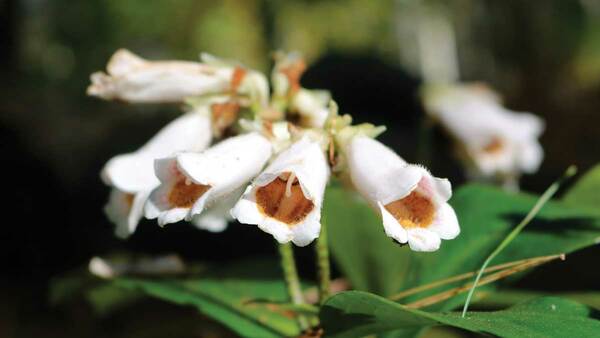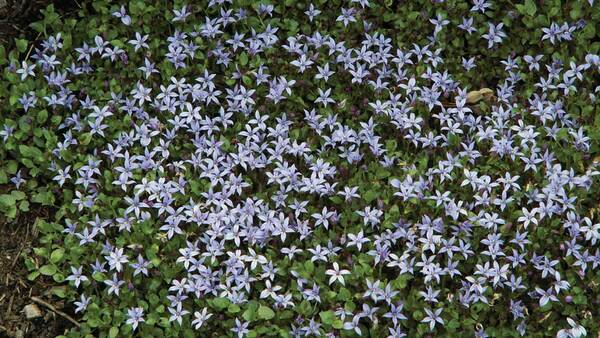
Fall is a wonderful time in the garden. The cool, crisp air encourages plants toward dormancy; perennial foliage starts to yellow and wither as deciduous trees paint the landscape with a kaleidoscope of colors. As we reluctantly accept the inevitable and begin preparing our gardens for winter, we can ease the transition by planting selections that provide color and excitement at this time of year. While many gardeners have traditionally turned to mums (Chrysanthemum spp. and cvs., Zones 5–9), goldenrods (Solidago spp. and cvs., Zones 3–9), and sedums (Hylotelephium spp. and cvs., Zones 3–9) to extend the gardening season, many also long for something different. Luckily, there are many unusual, lesser-known fall-blooming perennials that offer gardeners exciting opportunities to create dynamic, late-season displays.
Spectacular plant picks for sunny spots

Name: ‘Ozawa’ allium (Allium thunbergii ‘Ozawa’)
Zones: 4–9
Size: 18 to 24 inches tall and 10 to 15 inches wide
Conditions: Full sun to partial shade; medium, well-drained soil
Native range: Japan, Korea, coastal China
Alliums typically make wonderful contributions to mixed spring and summer beds and borders. Stunning globes in shades of pink, purple, and white sit atop stems ranging from a diminutive 8 inches to a towering 4 feet in height. ‘Ozawa’ allium, which starts to bloom in September, is one of the latest-flowering alliums in the genus. Somewhat droopy spheres of luscious, lavender-purple flowers rise above mounds of attractive grasslike foliage. Unlike some alliums, ‘Ozawa’ rarely produces seedlings and is not aggressive. Best suited to free-draining soil, this floriferous bulbous plant blooms for weeks and will be abuzz with happy, hungry bees in the waning light of autumn days.

Name: ‘Arendsii’ monkshood (Aconitum carmichaelii ‘Arendsii’)
Zones: 3–7
Size: 2 to 4 feet tall and 1 to 2 feet wide
Conditions: Full sun to partial shade; moist, well-drained soil
Native range: Central China
“Better late than never” could be said about the flowers of monkshood, which usually don’t start blooming in earnest until early to mid-October. ‘Arendsii’ monkshood features 4-foot-tall stems topped with dense panicles of richly saturated cobalt-blue flowers. Place this stately perennial toward the back of the border in rich, consistently moist but not overly wet soil. Sunny sites are fine for cooler regions, as long as the soil is not allowed to dry out, while gardeners in warmer areas should provide dappled shade. If you are like me and usually forget to provide support to tall perennials likely to flop, ‘Arendsii’ will put your mind at ease; its stout stems stand at attention, rarely requiring staking. But be sure to wear gloves while handling this plant, as all parts of it are poisonous.
Name: ‘Plum Peachy’ narrow-leaf ironweed (Vernonia angustifolia ‘Plum Peachy’)
Zones: 5–8
Size: 3 to 4 feet tall and 2 to 2½ feet wide
Conditions: Full sun; medium to moist, well-drained soil
Native range: Southeastern United States
‘Plum Peachy’ narrow-leaf ironweed sports clusters of vibrant lavender-violet flowers that contrast spectacularly with the warm-colored tones of other plants in fall. As the common name suggests, the foliage is thin and linear; it looks a lot like bluestar (Amsonia spp. and cvs., Zones 5–9) foliage. The leaves add a wonderful contrasting texture when placed near big, bold-foliaged neighbors. Although this species is native to the Southeast, it does well in more northern climates. Here in the Northeast, the graceful clumps don’t start to flower until October and continue to bloom for several weeks or until a killing frost, to the delight of late-flying pollinators. As a bonus, the narrow foliage takes on a purplish blush toward the middle of fall, just in time to highlight the violet flowers.

Name: ‘Snow Flurry’ heath aster (Symphyotrichum ericoides var. prostratum ‘Snow Flurry’)
Zones: 3–9
Size: 3 to 8 inches tall and 1 to 3 feet wide
Conditions: Full sun to partial shade; dry to moist, well-drained soil
Native range: North America
Finding a ground cover that produces flowers in autumn can be difficult, but when you succeed it’s definitely cause for celebration! Diminutive ‘Snow Flurry’ heath aster is a prostrate form of native heath aster. Its stiff, arching stems, which are covered in needlelike foliage, look a little like a creeping juniper (Juniperus spp. and cvs., Zones 3–9). When ‘Snow Flurry’ blooms in midfall, the abundance of tiny white flowers often entirely conceals the leaves. A lover of sun and well-drained soil, this little powerhouse is the perfect choice for rock gardens or the front of a sunny border. Its unique, creeping habit is especially effective when the stems are allowed to cascade over stone walls or meander between rocks. It looks wonderful planted en masse where it can truly look like a blanket of snow.

Name: ‘Blackhawks’ big bluestem (Andropogon gerardii ‘Blackhawks’)
Zones: 3–9
Size: 4 to 5 feet tall and 1 to 2 feet wide
Conditions: Full sun; dry to medium, well-drained soil
Native range: North America
Ornamental grasses are structural plants that act as the backbone of garden plantings, frequently adding nearly year-round color and texture to designs. However, it’s in fall when most step up and capture our attention. One of the most impactful native grasses is big bluestem, which can achieve an impressive height. ‘Blackhawks’ big bluestem possesses all the great qualities of the species, along with one big bonus: The wide, graceful blades that emerge green in spring gradually shift to purple and finally a dark purple-black as fall progresses. Elegant flowering stems may rise 7 feet tall, topped by three-parted inflorescences that look like turkey plumage. Like all other big bluestems, ‘Blackhawks’ is an adaptable, drought-tolerant plant that performs admirably with little care. Avoid very fertile or amended soil as well as shade; these conditions will cause lodging or flopping. To take full advantage of the dramatic color of ‘Blackhawks’, dot it periodically throughout a garden bed, or if space allows, make a statement and plant this exceptional nativar en masse. And for those of us who garden in deer country, Bambi and friends will walk on by.
Gorgeous plant selections that shine in shade
Name: Yellow wax bells (Kirengeshoma palmata)
Zones: 5–8
Size: 3 to 5 feet tall and 2 to 4 feet wide
Conditions: Partial to full shade; moist, well-drained soil
Native range: Japan, Korea, northeast China
One plant that would make a wonderful addition to the garden for its foliage, even if it never produced a single flower, is yellow wax bells. This hydrangea relative can grow to shrublike proportions in shady areas with moist, well-drained soil. Sturdy stems dressed in bold, sycamore-like leaves add structure and texture to a shady border. In early fall, terminal, branched clusters of gumball-shaped flower buds open to butter yellow bells; these flowers have a prolonged bloom period. Yellow wax bells is a favorite of slugs and snails, so keep some diatomaceous earth on hand to deal with these unwelcome visitors.

Name: ‘Cheju-Do’ Japanese bugbane (Actaea japonica ‘Cheju-Do’)
Zones: 4–9
Size: 2 to 4 feet tall and 1½ to 2 feet wide
Conditions: Partial to full shade; moist, well-drained soil
Native range: Japan, China, Korea
When most people think of bugbane, they usually picture Actaea simplex (Zones 3–8), a late summer bloomer with several selections sporting stunning purple-black foliage. ‘Cheju-Do’ Japanese bugbane, which is from Cheju Island in South Korea, I is lesser-known cousin that deserves gardeners’ attention. Preferring moist soil and shaded environments, ‘Cheju-Do’ Japanese bugbane produces attractive clumps of dark-green lobed leaves that appear as if they had been dipped in resin. From underneath the glossy leaves emerge erect stems with pearl-like flower buds that open to small white stars, adding a striking vertical element to any shady border. The combination of its exceptional foliage and fall flowers makes this plant a must for any low-light spot.
Name: Weeping golden toad lily (Tricyrtis macrantha subsp. macranthopsis)
Zones: 4–9
Size: 1½ to 2 feet tall and wide
Conditions: Partial to full shade; moist, well-drained soil
Native range: Japan
In summer, weeping golden toad lily fades into the background of a woodland border with its shrubby, arching habit of glossy green leaves. It’s not until midfall when it grabs your attention with 1- to 2-inch-long yellow, bell-shaped flowers. Bending over and looking inside the flowers will reveal maroon insides. Because these alluring flowers are best seen when looked at from below, consider planting this toad lily where it can cascade over rocks or a wall. Consistent moisture, rich, fertile soil, and dappled shade are a must in order to keep the leaves looking their best. Crispy, brown leaf edges can be expected when soil is allowed to dry out, so keep the hose handy.

Name: Japanese shrub mint (Leucosceptrum stellipilum)
Zones: 5–8
Size: 2 to 3 feet tall and 2½ to 3 feet wide
Conditions: Partial to full shade; moist, well-drained soil
Native range: Japan
Japanese shrub mint is an underused woodland perennial whose habit is very shrublike. All this perennial needs to be happy are shade and soil that doesn’t dry out. Its semi-woody stems reach 3 feet tall, forming rounded mounds of coarsely toothed, fuzzy, hydrangea-like foliage. Deer ignore this plant, and it looks attractive throughout the growing season. By midfall, the end of each stem blooms with unique 3- to 4-inch-long angular inflorescences with bracts arranged in a herringbone pattern. From the bracts emerge small, pale lavender flowers that turn the inflorescences into sparkling wands.
Try out one of these unusual fall perennials, and watch as your autumn garden transforms from a fading, transitional group of plants into a spectacular display.
Dividing perennials is one of the easiest and cheapest ways to get more plants. Here are some principles and guidelines to keep in mind for best results.
Designing for year-round interest

While this design works hard all year, it looks spectacular in autumn. ‘Blackhawks’ big bluestem towers above the display in majestic pillars of fine-textured purple-black foliage. Below, a large mound of native Arkansas bluestar shines with orange-chartreuse foliage, while the dark green foliage of ‘Plum Peachy’ narrow-leaf ironweed stands in contrast to its frilly, light purple flowers. That periwinkle color is echoed in the globelike flowers of low, mounding ‘Ozawa’ allium. A carpet of Rozanne geranium surrounding the alliums shows off its multicolored red, orange, and green fall foliage. Above the scene, the graceful arms of weeping Lavender Twist® Eastern redbud are adorned with heart-shaped chartreuse leaves that echo the yellow foliage of Arkansas bluestar.
1. ‘Blackhawks’ big bluestem

2. Arkansas bluestar (Amsonia hubrichtii, Zones 5–8)
Arkansas bluestar is adorned with clusters of star-shaped light blue flowers in spring. Its stripy leaves add texture to any design through spring, summer, and fall, and its faded foliage remains standing, grasslike, throughout winter.
3. ‘Plum Peachy’ narrow-leaf ironweed
4. ‘Ozawa’ allium

5. Rozanne geranium (Geranium ‘Gerwat’, Zones 5–8)
Rozanne geranium has tiny purple-blue flowers with white centers. While the flowers bloom in spring, they can also bloom sporadically throughout the rest of the growing season.

6. Lavender Twist® Eastern redbud (Cercis canadensis ‘Covey’, Zones 5–9)
During winter, the bare branches of Lavender Twist® Eastern redbud add structure to empty garden beds. In spring, a profusion of purple-pink flowers erupts all along the branches. Then in summer, large green leaves completely cover the tree, sometimes eclipsing the branches.
Andy Brand is the director of horticulture at Coastal Maine Botanical Gardens in Boothbay.






















Comments
Log in or create an account to post a comment.
Sign up Log in